Related Research Articles
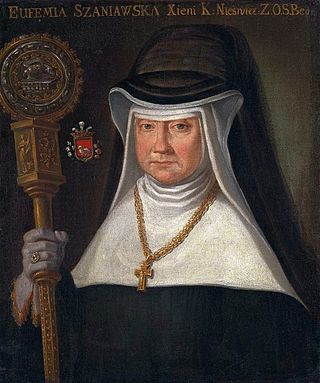
An abbess is the female superior of a community of nuns in an abbey.

A monastery is a building or complex of buildings comprising the domestic quarters and workplaces of monastics, monks or nuns, whether living in communities or alone (hermits). A monastery generally includes a place reserved for prayer which may be a chapel, church, or temple, and may also serve as an oratory, or in the case of communities anything from a single building housing only one senior and two or three junior monks or nuns, to vast complexes and estates housing tens or hundreds. A monastery complex typically comprises a number of buildings which include a church, dormitory, cloister, refectory, library, balneary and infirmary, and outlying granges. Depending on the location, the monastic order and the occupation of its inhabitants, the complex may also include a wide range of buildings that facilitate self-sufficiency and service to the community. These may include a hospice, a school, and a range of agricultural and manufacturing buildings such as a barn, a forge, or a brewery.

A nun is a woman who vows to dedicate her life to religious service and contemplation, typically living under vows of poverty, chastity, and obedience in the enclosure of a monastery or convent. The term is often used interchangeably with religious sisters who do take simple vows but live an active vocation of prayer and charitable work.

A convent is an enclosed community of monks, nuns, friars or religious sisters. Alternatively, convent means the building used by the community.

The Poor Clares, officially the Order of Saint Clare, originally referred to as the Order of Poor Ladies, and also known as the Clarisses or Clarissines, the Minoresses, the Franciscan Clarist Order, and the Second Order of Saint Francis, are members of an enclosed order of nuns in the Roman Catholic Church. The Poor Clares were the second Franciscan branch of the order to be established. Founded by Clare of Assisi and Francis of Assisi on Palm Sunday in the year 1212, they were organized after the Order of Friars Minor, and before the Third Order. As of 2011, there were over 20,000 Poor Clare nuns in over 75 countries throughout the world. They follow several different observances and are organized into federations.
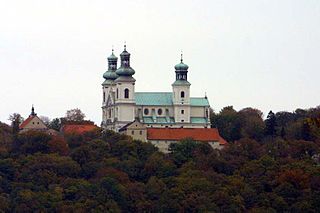
The Camaldolese Hermits of Mount Corona, commonly called Camaldolese, is a monastic order of Pontifical Right for men founded by Saint Romuald. Its name is derived from the Holy Hermitage of Camaldoli, high in the mountains of central Italy, near the city of Arezzo. Its members add the nominal letters E.C.M.C. after their names to indicate their membership in the congregation. Apart from the Roman Catholic monasteries, in recent times ecumenical Christian hermitages with a Camaldolese spirituality have arisen as well.
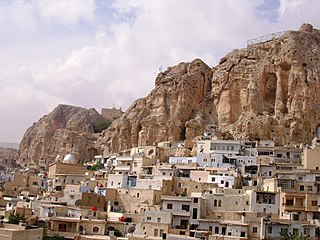
Maaloula is a town in the Rif Dimashq Governorate in Syria. The town is located 56 km to the northeast of Damascus and is built into the rugged mountainside at an altitude of more than 1,500m. It is known as one of two remaining villages where Western Neo-Aramaic is spoken, the other one being the nearby smaller village of Jubb'adin. Until the Syrian Civil War, Bakhʽa also had speakers of Western Neo-Aramaic. However, Bakhʽa was completely destroyed during the war, and all the survivors fled to other parts of Syria or to Lebanon.

A double monastery is a monastery combining separate communities of monks and of nuns, joined in one institution to share one church and other facilities. The practice is believed to have started in the East at the dawn of monasticism. It is considered more common in the monasticism of Eastern Christianity, where it is traceable to the 4th century. In the West the establishment of double monasteries became popular after Columbanus and sprang up in Gaul and in Anglo-Saxon England. Double monasteries were forbidden by the Second Council of Nicaea in 787, though it took many years for the decree to be enforced. Double monasteries were revived again after the 12th century in a significantly different way when a number of religious houses were established on this pattern among Benedictines and possibly the Dominicans. The 14th-century Bridgittines were purposely founded using this form of community.

Buddhist monasticism is one of the earliest surviving forms of organized monasticism and one of the fundamental institutions of Buddhism. Monks and nuns, called bhikkhu and bhikkhuni, are responsible for the preservation and dissemination of the Buddha's teaching and the guidance of Buddhist lay people. Three surviving traditions of monastic discipline (Vinaya), govern modern monastic life in different regional traditions: Theravada, Dharmaguptaka, and Mulasarvastivada.

Nunsploitation is a subgenre of exploitation film which had its peak in Europe in the 1970s. These films typically involve Christian nuns living in convents during the Middle Ages.
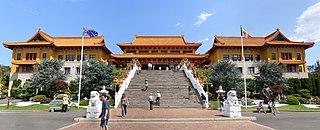
In Australia, Buddhism is a minority religion. According to the 2021 census, 0.2 percent of the total population or 30,474 of Australia identified as Buddhist. It was also the fastest-growing religion by percentage, having increased its number of adherents by 79 percent between the 1996 and 2001 censuses. The highest percentage of Buddhists in Australia is present in Christmas Island, where Buddhists constitute 18.1% of the total population according to the 2016 Census. Buddhism is the fourth largest religion in the country after Christianity, Islam and Hinduism.
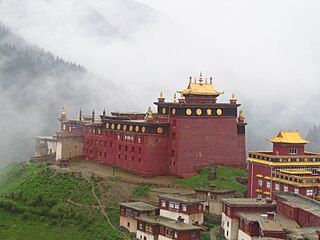
Palpung Monastery is the name of the congregation of monasteries and centers of the Tai Situpa lineage of the Kagyu school of Tibetan Buddhism as well as the name of the Tai Situ's monastic seat in Babang, Kham. Palpung means "glorious union of study and practice". It originated in the 12th century and wielded considerable religious, political, and economic influence over the centuries.

Stanbrook Abbey is a Catholic contemplative Benedictine Monastery with the status of an abbey, located at Wass, North Yorkshire, England.

Thiksey Monastery or Thiksey Gompa is a Buddhist monastery affiliated with the Gelug school of Tibetan Buddhism. It is located on top of a hill in Thiksey approximately 19 kilometres (12 mi) east of Leh, in the Ladakh region of northern India. It is noted for its resemblance to the Potala Palace in Lhasa, Tibet, and is the largest monastery in central Ladakh, notably containing a separate set of buildings for female renunciates that has been the source of significant recent building and reorganization.

San Salvatore is a former monastery in Brescia, Lombardy, northern Italy, now turned into a museum. The monastic complex is famous for the diversity of its architecture which includes Roman remains and significant pre-Romanesque, Romanesque and Renaissance buildings.

San Vincenzo al Volturno is a historic Benedictine monastery located in the territories of the Comunes of Castel San Vincenzo and Rocchetta a Volturno, in the Province of Isernia, near the source of the river Volturno in Italy. The current monastery, housing a group of eight Benedictine nuns, is located to the east of the river, while the archaeological monastery of the early Middle Ages was located on the west.
The Order of the Most Holy Redeemer, also commonly known as the Redemptoristines, is a female contemplative religious order of the Catholic Church. It was formed in 1731, and is the female counterpart to the Redemptorists.
The Monastery of the Virgins is a structure uncovered during Benjamin Mazar's excavations south of Jerusalem's Temple Mount. The large number of Christian religious finds from the site have prompted its identification with a monastery described by a pilgrim, Theodosius the archdeacon, in his De Situ Terrae Sanctae, a work of the early 6th century. The building was constructed in the 4th century on the remains of an earlier Herodian building identified with the Second Temple courthouse, and was destroyed during the Persian sack of Jerusalem in 614.
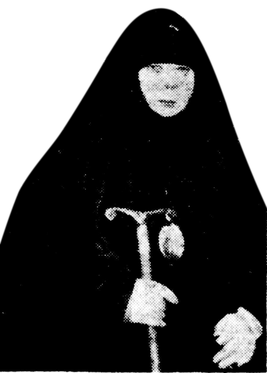
Abbess Mariam Soulakiotis, née Marina Soulakiotou, also known either to her followers as Mariam of Keratea, or in contemporary media pejoratively as "Mother Rasputin", was a Greek Old Calendarist Eastern Orthodox abbess and serial killer who was found guilty of numerous counts of murder, fraud and other crimes, which public prosecutors of the Kingdom of Greece alleged she committed against both laypeople and other nuns in her abbey between 1939 and her arrest in December 1950.
Ayya Nirodha is an Australian Buddhist nun. Her story was featured in the Buddhist Life Stories of Australia Project (2014–2015).